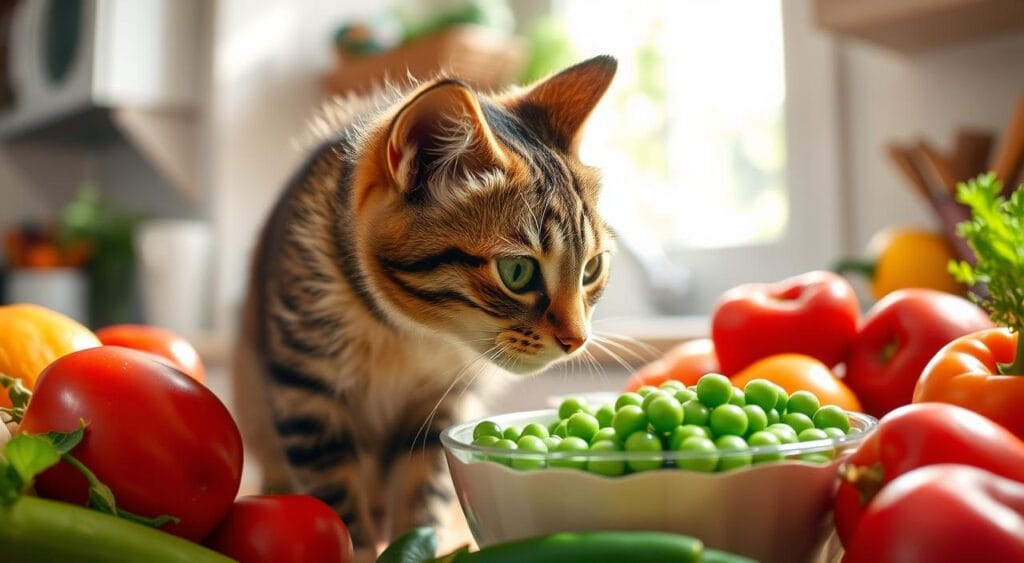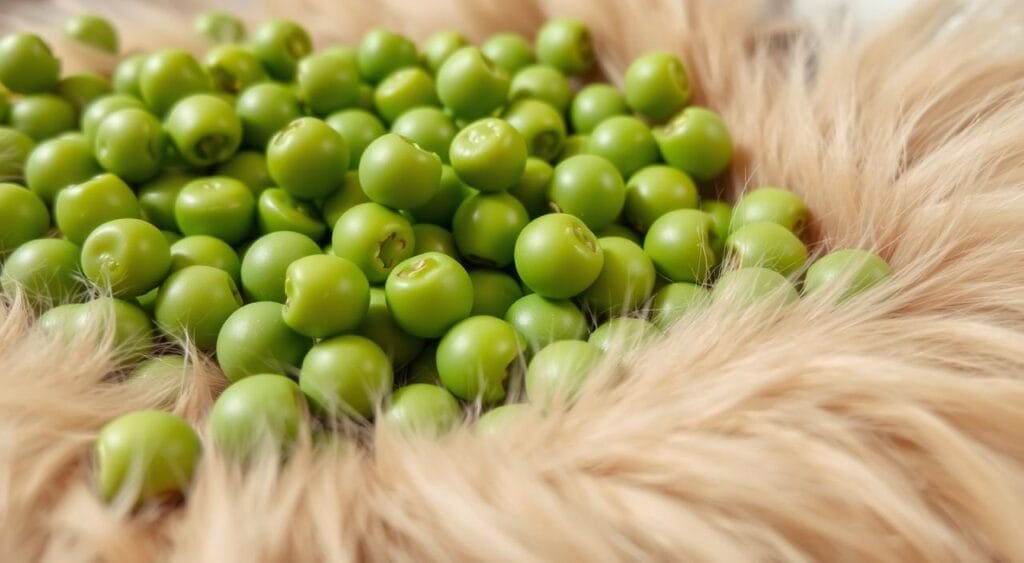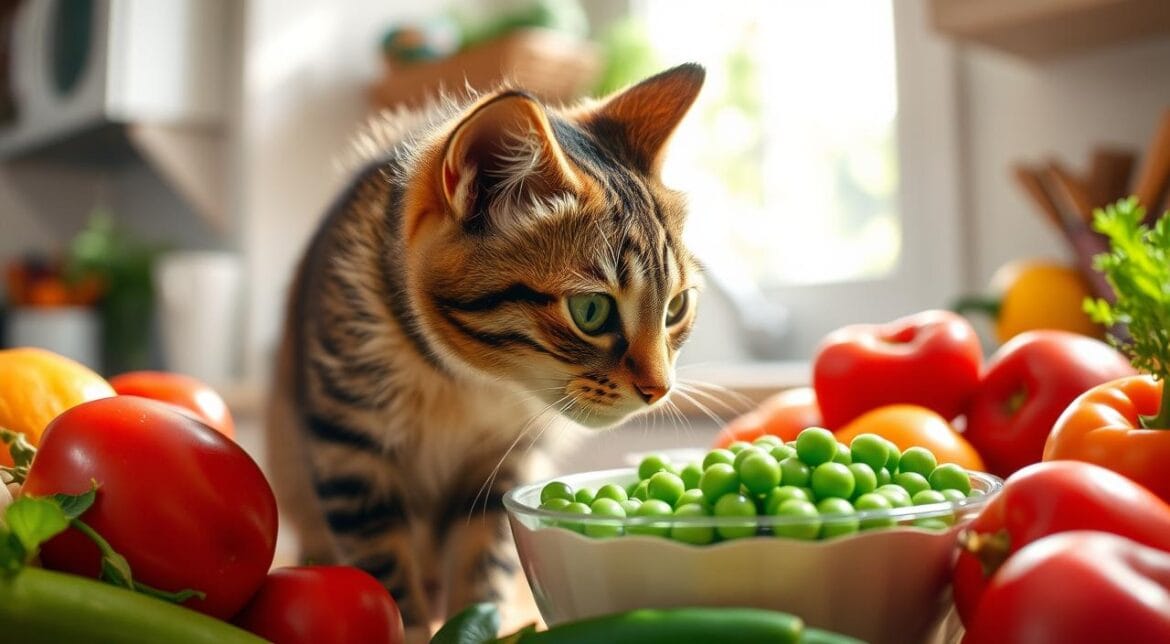Table of Contents
As a responsible pet owner, you might wonder if peas are good for your cat. The idea of adding peas to your cat’s diet has sparked a lot of debate. In this article, we’ll look at the good and bad sides of peas for cats. This will help you decide if peas are right for your furry friend.

Key Takeaways
- Peas can provide essential vitamins, minerals, and fiber for cats in moderation.
- Different types of peas, such as fresh, frozen, and canned, have varying safety considerations.
- Potential risks include digestive issues and allergic reactions, so introduction should be gradual.
- Consulting your veterinarian is recommended to ensure peas are a suitable addition to your cat’s diet.
- Peas can be a healthy supplement, but should not replace your cat’s primary protein-based food.
The Nutritional Value of Peas for Cats
Peas are great for your cat’s diet. They are full of vitamins, minerals, protein, and fiber. These small green legumes offer many health benefits for your furry friend.
Essential Vitamins in Peas
Peas are packed with vitamins A, C, and K. They also have B-complex vitamins like folate and vitamin B6. These vitamins help your cat’s vision, immune system, and organ function. They keep your cat happy and healthy.
Mineral Content Benefits
Peas are also rich in minerals like iron, zinc, and magnesium. These minerals are good for your cat’s blood, bones, and energy. Adding peas to your cat’s cat nutrition is a smart choice.
Protein and Fiber Components
Peas are a good source of plant-based pea nutrients for cats. They have protein and fiber. The protein helps your cat’s muscles, and the fiber supports digestion and regular bowel movements.
| Nutrient | Amount in Peas | Benefits for Cats |
|---|---|---|
| Vitamins | A, C, K, B6, Folate | Vision, Immune System, Organ Function |
| Minerals | Iron, Zinc, Magnesium | Healthy Blood, Bone Development, Energy Metabolism |
| Protein | Moderate Amount | Muscle Development and Maintenance |
| Fiber | Good Source | Healthy Digestion and Regular Bowel Movements |
Adding peas to your cat’s feline diet supplements makes their diet better. It supports their health and energy.

Can Cats Eat Peas? Safety and Guidelines
Many pet owners wonder if peas are safe for their cats. It’s important to know the cat food safety and feline dietary restrictions to keep your cat healthy. Let’s look into whether cats can eat peas and how to keep them well-fed and happy.
Peas can be good for cats in small amounts. They offer vitamins, minerals, and fiber that can help their diet. But, it’s key to introduce peas slowly and watch for any signs of upset stomach or allergies.
- Start with small portions, no more than a teaspoon per meal, to allow your cat’s digestive system to adjust.
- Ensure the peas are cooked thoroughly and mashed or pureed to make them easier for your cat to digest.
- Avoid feeding your cat canned or frozen peas, as they may contain added salt, seasonings, or preservatives that can be harmful to felines.
Always put your cat’s health first when thinking about their diet. If you’re unsure about adding peas or new foods, talk to your vet. They can give advice on feline dietary restrictions and help with a pet nutrition guidelines-approved diet plan.
“Responsible pet owners should make their cat’s health and well-being a top priority when considering changes to their diet.”
By following these tips and talking to your vet, you can add peas to your cat’s diet safely. This way, you can give them a nutritious and balanced meal.
Different Types of Peas and Their Safety for Cats
Feeding peas to your cat requires knowing the differences between types. Fresh, frozen, and canned peas each have their own safety considerations. Each option affects your cat’s health differently.
Fresh Garden Peas
Fresh garden peas, like snap peas or snow peas, are safe for cats in small amounts. They are full of vitamins, minerals, and fiber. But, make sure they are free from harmful pesticides or chemicals.
Frozen Peas
Frozen peas are a good choice for cats. Freezing keeps their nutrients intact and avoids harmful additives. Always thaw them before giving them to your cat to avoid digestive problems.
Canned Peas Considerations
Canned peas are not the best choice for cats. They often have salt, sugar, or other harmful ingredients. The canning process can also reduce their nutritional value. If you must use canned peas, choose low-sodium ones and rinse them well.
The safest peas for your cat are fresh or frozen ones. Make sure they are plain and without seasonings. Always introduce new foods slowly to watch for any health issues or allergies.
| Type of Peas | Suitability for Cats | Key Considerations |
|---|---|---|
| Fresh Garden Peas | Safe in moderation | Ensure purity from pesticides and chemicals |
| Frozen Peas | Safe and convenient | Thaw thoroughly to prevent digestive issues |
| Canned Peas | Not recommended | Often contain added salt, sugar, and preservatives |
Health Benefits of Peas in Your Cat’s Diet
Adding peas to your cat’s food can be very beneficial. Peas are packed with vitamins, minerals, and other nutrients. These can help keep your cat healthy and happy.
Promoting Feline Health
Peas are full of fiber, which is good for your cat’s digestive system. The fiber in peas helps with regular bowel movements and can even help with inflammatory bowel disease. Plus, the antioxidants in peas, like vitamin C and E, boost your cat’s immune system and protect their cells.
Enhancing Nutritional Intake
Peas are a great source of vitamins and minerals that your cat needs. They have lots of vitamins A, B, and K, and minerals like iron, zinc, and magnesium. These nutrients are important for your cat’s vision, skin, coat, muscles, and energy.
Also, peas have plant-based protein that can help your cat’s diet. This mix of proteins helps keep your cat’s muscles strong and supports their growth.
| Nutrient | Benefits for Cats |
|---|---|
| Fiber | Supports digestive health, prevents constipation, and alleviates inflammatory bowel disease |
| Antioxidants (Vitamin C and E) | Strengthens the immune system and protects cells from oxidative damage |
| Vitamins (A, B, K) | Supports vision, skin and coat health, muscle function, and energy levels |
| Minerals (Iron, Zinc, Magnesium) | Contributes to overall health and well-being |
| Plant-based Protein | Complements animal-based proteins, helps maintain lean muscle mass |
Feeding peas to your cat can give them a nutritional boost. It supports their health and well-being. Always talk to your vet before changing your cat’s diet to make sure it’s right for them.
Potential Risks and Side Effects of Feeding Peas to Cats
Peas can be good for our cats, but we need to watch out for risks. Knowing these can help keep your cat healthy and happy.
Digestive Concerns
Cats’ stomachs are different, and new foods like peas can upset them. Some cats might get cat food allergies or feline digestive issues. This can cause vomiting, diarrhea, or belly pain.
Allergic Reactions
Cats can also have food allergies, just like people. Peas can cause skin problems, breathing issues, or even serious reactions. If your cat shows signs of an allergy, stop peas and talk to your vet.
Portion Control Guidelines
Feeding peas to your cat needs careful control. Too many peas can upset their stomach, throw off their diet, or make them gain weight. Start with small amounts and make sure peas are not more than 10% of their food.
Knowing these risks and following guidelines can help you add peas to your cat’s diet safely. This way, you can enjoy the benefits while keeping your cat healthy.
How to Introduce Peas to Your Cat’s Diet
Adding peas to your cat’s diet needs a slow and careful step. Cats can be picky, and sudden changes might upset their stomachs. By following simple steps, you can add peas to your cat’s meals safely.
- Start Small: Start with a tiny amount of peas, about the size of a pea. This lets your cat get used to the taste and texture without feeling overwhelmed.
- Monitor Reactions: Watch how your cat reacts to the peas. Look for signs like vomiting, diarrhea, or not wanting to eat. If your cat has a bad reaction, stop giving peas and talk to your vet.
- Gradual Increase: If your cat does okay with the first small amount, you can slowly add more peas. Do this over a few days or weeks. This lets your cat’s stomach get used to the new cat food introduction.
- Variety is Key: Mix peas with your cat’s usual new pet foods and other safe veggies. This helps your cat get used to the feline diet changes and keeps their stomach happy.
Introducing peas to your cat’s diet needs patience and watching closely. By going slow and paying attention, you can give your cat the good stuff from peas while keeping them healthy and happy.
Signs Your Cat May Not Tolerate Peas
Peas can be good for your cat’s diet, but some cats may not like them. It’s important to watch how your cat reacts to peas. Knowing the signs of discomfort or health issues can help keep your cat happy and healthy.
Physical Symptoms to Watch For
If your cat has cat food intolerance, look out for these signs:
- Vomiting
- Diarrhea
- Abdominal discomfort or bloating
- Skin irritation or rashes
- Excessive scratching or grooming
Behavioral Changes
Feline allergic reactions to peas can also show in behavior. Watch for:
- Decreased appetite or refusal to eat
- Lethargy or reduced activity levels
- Increased agitation or irritability
- Changes in litter box habits
If you notice these signs, consult your vet. They can find the problem and tell you what to do next.
Every cat is different, and how they react to peas can vary. By watching closely and acting fast, you can keep your cat healthy and happy.
Comparing Peas to Other Safe Vegetables for Cats
Feeding your cat can be a fun challenge. Peas are a safe and tasty choice. But, they’re not the only good option. Let’s see how peas stack up against green beans and spinach.
Green Beans are great for cats too. They’re low in calories and high in fiber, helping with digestion. Green beans also have vitamins A, C, and K, and manganese. Cats love their crunchy texture and fresh taste.
Spinach is full of vitamins and minerals good for cats. It’s rich in vitamins A, C, and K, folate, manganese, and iron. Spinach’s fiber helps with digestion. But, start with small amounts because it can upset some cats’ stomachs.
Looking at the nutrients, peas have more protein than green beans and spinach. This makes them a great protein source for cats. Plus, they’re low in calories, which is good for cats watching their weight.
While peas, green beans, and spinach are all good for cats, they each offer different benefits. Mixing these veggies into your cat’s diet can make meals more interesting and nutritious. This supports your cat’s health and happiness.
“Introducing a variety of safe vegetables to your cat’s diet can provide valuable nutrients and health benefits.”
Best Practices for Preparing Peas for Your Cat
Adding peas to your cat’s diet can be a great choice. But, it’s key to prepare them right. Follow a few easy steps to make sure your cat can enjoy peas safely.
Cooking Methods
Steaming or boiling peas is best for cats. It keeps the nutrients in and makes them easy to digest. Don’t add oils, salts, or spices, as they can make your cat sick. Just give them plain, unseasoned peas.
Serving Suggestions
You can give peas to your cat whole or mashed. Whole peas are fun and interactive, while mashed peas are easier to eat. Start with a little and add more as your cat gets used to it. Always have fresh, clean water ready with any pea snacks or meals.
FAQ
Can cats eat green beans?
Yes, cats can eat green beans in small amounts. They are a healthy choice that adds vitamins, minerals, and fiber. But, start slow and watch how your cat reacts.
Can cats have spinach?
Cats can have spinach in small amounts as a treat. But, it should not be a big part of their diet. Spinach has oxalates that can be bad for cats in large amounts. Always check with your vet before giving spinach to your cat.
Can cats eat peas?
Yes, cats can eat peas in moderation. They are full of vitamins, minerals, and fiber. But, start with a little and watch for any signs of trouble.
What are the nutritional benefits of peas for cats?
Peas are packed with vitamins A, C, K, folate, and iron. They also have protein and fiber, which are good for your cat’s health and digestion.
Are there any risks or side effects of feeding peas to cats?
Feeding peas to cats can cause digestive problems like gas or diarrhea. Some cats might also have allergic reactions. Begin with a small amount and monitor for any adverse reactions.. If you’re worried, talk to your vet.
How can I safely introduce peas to my cat’s diet?
Start with a few cooked, unsalted peas and slowly add more. Watch for any signs of trouble. If your cat does well, you can add peas to their meals, but remember to keep the portions right.
How do peas compare to other safe vegetables for cats, such as green beans and spinach?
Peas, green beans, and spinach are all safe for cats in small amounts. Peas and green beans offer similar benefits like vitamins and fiber. Spinach has oxalates that can be harmful in large amounts. Always talk to your vet to find the best veggies for your cat.

